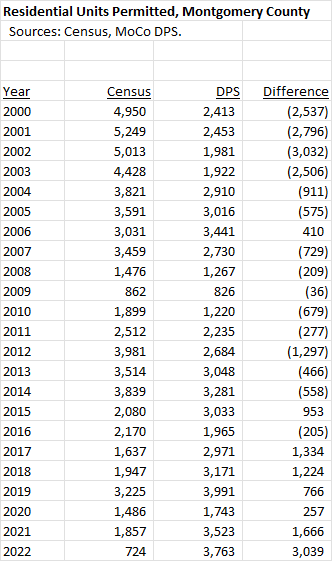By Adam Pagnucco.
Two days ago, I wrote a post about the fact that building permit data published by the U.S. Census Bureau showed that Montgomery County permitted the lowest number of housing units since at least 1990. The county government has responded that Census is wrong and has released its own estimates of county building permits.
First, let’s understand how Census estimates building permits. According to its methodology statement:
The statistics from the Building Permits Survey are based on reports that are submitted by local building permit officials in response to a voluntary mail survey. The data are collected using Form C-404, “Report of Building or Zoning Permits Issued for New Privately-Owned Housing Units.” Annual respondents receive an introductory letter each year…
Building permits data are collected from individual permit offices, most of which are municipalities; the remainder are counties, townships, or New England and Middle Atlantic-type towns. Because building permits are public records, local area data can be published without any confidentiality concerns. From local area data, estimates are tabulated for counties, states, metropolitan areas, Census Divisions, Census Regions, and the United States. Data are also collected for Puerto Rico and U.S. territories, although these areas are excluded from the national estimates.
So in theory, the source for Census building permit information is local governments. Since our county is one of the largest in the United States, we might expect our government to participate in Census’s survey. But that may not be the case as we explain below.
Soon after I published my post, county officials began to look into the mismatch between Census’s data and the data maintained by our Department of Permitting Services (DPS). I have been using Census building permit data for years and this is the first time I can recall this issue being examined at this level of detail. I appreciate the efforts by Assistant Chief Administrative Officer Jake Weissmann and county spokesman Scott Peterson to investigate this.
The table below shows the number of permitted units estimated by Census along with the number estimated by DPS since 2000.

As you can see, Census’s numbers have never matched the internal numbers produced by DPS. This is interesting because Census’s numbers are supposed to be based on survey responses from local jurisdictions. There is also a pattern of variation, with Census almost always exceeding DPS prior to 2015 and usually falling short since then. The gap is particularly large in the last two years.
So why are these two data series so different? That question is still being investigated but here are some preliminary responses that have been sent to me.
First, DPS believes that Census’s reported unit count for 2022 is actually a building count. The two numbers are often different because multi-unit buildings of course include multiple units. The county commented:
The most recent Census data shows the number of building permits issued by DPS, not the number of individual units. Although the data description mentions housing units, the term “building permits”, from a DPS perspective, refers to the main permits and not the number of units within each one—and the most recent number is very close to the total number of permits issued by DPS in 2022, not individual units.
Even if this is true, it doesn’t necessarily explain the divergence between the estimates – and the patterns of that divergence – going back two decades.
The county also said, “The numbers never matched—see comparison attached. It could be because some of the municipalities in Montgomery County (e.g., Rockville, Takoma Park) are not under DPS’s jurisdiction and have separate reporting mechanisms. In the past 5 years, DPS’s numbers were consistently higher than the Census number though.”
That’s curious. If municipalities were included, Census’s numbers would be higher than DPS. In some years, that has been true, but in others, it was not true.
Then there is this bombshell. The county said, “DPS was not able to determine how the Census obtained the data. Our residential team manager is not the one sharing the data with the Census.”
If Census did not get their data from the county, then where did it come from? Where else could it come from? The county DPS and the permitting offices of Rockville and Gaithersburg are the issuers of building permits and the original custodians of permit data. Any worthwhile data would have to come from them.
Folks, I have been crunching economic data for almost 30 years and I have not heard of another case like this. The subject is now under investigation by DPS and I have been told that when they learn more, they will tell me. In the meantime, I’m grateful to Jake Weissmann and the executive branch for trying to figure this out. I look forward to reporting more as their inquiry continues.
